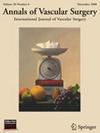Long-Term Outcomes and Risk Factors after Hybrid Thoracic Endovascular Aortic Repair with Landing in Zones 1 and 2
IF 1.6
4区 医学
Q3 PERIPHERAL VASCULAR DISEASE
引用次数: 0
Abstract
Background
This study aimed to examine the outcomes of zones 1 and 2 landing hybrid thoracic endovascular aortic repair (TEVAR) and to examine risk factors associated with poor outcomes.
Methods
From April 2014 to March 2024, 96 patients underwent zones 1 and 2 landing hybrid TEVAR for aortic arch pathologies (median age: 78 years). The primary endpoint was major adverse aorta-related events (late rupture/dissection and/or aorta-related reintervention). The secondary endpoint was type 1a endoleak. Outcomes were analyzed by Kaplan–Meier and log-rank tests; risk factors by Cox regression. Median follow-up was 3.0 years.
Results
The 30-day mortality rate was 2.1% and the stroke rate was 4.2%. The aortic events rate at 7 years was 38.1%. In multivariate analysis, age (hazard ratio [HR] 1.06; 95% confidence interval [CI], 1.00–1.12; P = 0.023) and early era (HR 5.59; 95% CI, 1.23–25.3; P = 0.025) were significant risk factors for aortic events. Type 1a endoleak rates were significantly lower in the late-era group than in the early-era group (P = 0.003). The diameter of proximal landing zone in the early-era group was larger than that in the late-era group (P < 0.001); however, the oversizing rate of proximal stent grafts in the early-era group was smaller than that in the late-era group (P < 0.001). The aortic events and type 1a endoleak rates were significantly lower in the late-era group than in the early-era group (P = 0.003 and P = 0.011).
Conclusion
To prevent type 1a endoleak and aortic events, strict patient selection including preoperative measurement and surgeon skill are required. Hybrid TEVAR should be performed in an experienced facility.
混合型胸腔血管内主动脉修复术后1区和2区着陆的长期预后和危险因素。
目的:本研究旨在探讨1区和2区混合式胸血管内主动脉修复术(TEVAR)的预后,并探讨与预后不良相关的危险因素。方法:2014年4月至2024年3月,96例主动脉弓病变患者行1区和2区着陆混合TEVAR(中位年龄:78岁)。主要终点是主动脉相关的主要不良事件(晚期破裂/夹层和/或主动脉相关的再干预)。次要终点为1a型内漏。结果分析采用Kaplan-Meier检验和log-rank检验;危险因素的Cox回归分析。中位随访时间为3.0年。结果:30天死亡率为2.1%,卒中发生率为4.2%。7年主动脉事件发生率为38.1%。在多因素分析中,年龄(HR 1.06; 95% CI, 1.00-1.12; P=0.023)和早期(HR 5.59; 95% CI, 1.23-25.3; P=0.025)是主动脉事件的重要危险因素。晚期组1a型内漏率明显低于早期组(p=0.003)。早期组近端着陆区直径大于晚期组(p结论:为预防1a型内漏和主动脉事件,需要严格的患者选择,包括术前测量和手术技巧。混合TEVAR应在经验丰富的设备中进行。
本文章由计算机程序翻译,如有差异,请以英文原文为准。
求助全文
约1分钟内获得全文
求助全文
来源期刊
CiteScore
3.00
自引率
13.30%
发文量
603
审稿时长
50 days
期刊介绍:
Annals of Vascular Surgery, published eight times a year, invites original manuscripts reporting clinical and experimental work in vascular surgery for peer review. Articles may be submitted for the following sections of the journal:
Clinical Research (reports of clinical series, new drug or medical device trials)
Basic Science Research (new investigations, experimental work)
Case Reports (reports on a limited series of patients)
General Reviews (scholarly review of the existing literature on a relevant topic)
Developments in Endovascular and Endoscopic Surgery
Selected Techniques (technical maneuvers)
Historical Notes (interesting vignettes from the early days of vascular surgery)
Editorials/Correspondence

 求助内容:
求助内容: 应助结果提醒方式:
应助结果提醒方式:


